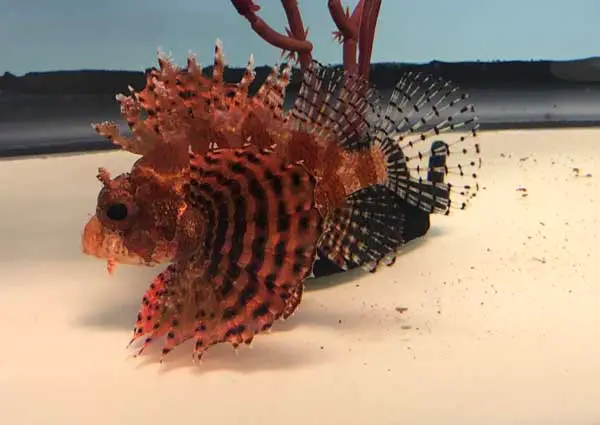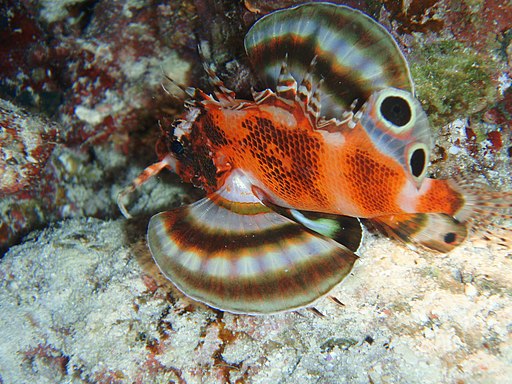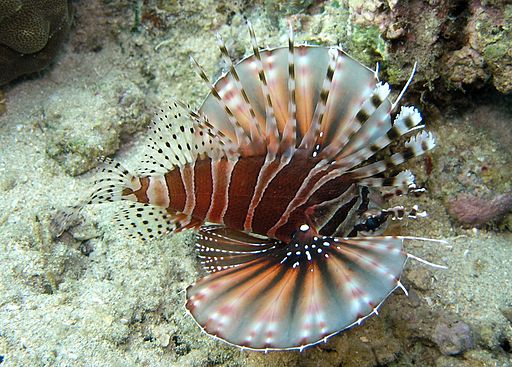Dwarf lionfish (or is it lionfishes?) are popular and intriguing saltwater fish because of their remarkable coloration and shape. But they also add interest because of the graceful yet venomous danger held in their iconic, flowing fins. The most popular species in this genus are Dendrochirus biocellatus (Fu Manchu or two spot), D. brachypterous (dwarf fuzzy Lionfish), and D. zebra (dwarf zebra lionfish). And if you’ve ever found yourself curious about these striped beauties, we’ll make sure to pique your interest even further!
Table of Contents: Dwarf Lionfish Care
- Quick Facts
- Dwarf Lionfish Tank Size
- Acclimation of Your Lionfish
- Feeding Dwarf Lionfish
- Dwarf Lionfish Tank Mates
- The Lionfish Sting
- Most Popular Dwarf Lionfish Species
- For More Information
Quick Facts

- Scientific Names: Dendrochirus biocellatus, Dendrochirus brachypterous, Dendrochirus zebra
- Common Names: Fu Manchu, Dwarf fuzzy, Dwarf zebra, Two spot
- Aggression Level: Very aggressive. Will eat everything it can swallow
- Care Level Required: Easy; Just watch out for the spines
- Diet: Carnivore
- Tank Type: Large predator
- Warnings & Precautions: Dwarf lionfish are protected by venomous spines. Use caution when your hands are inside the aquarium
- Water Parameters:
- Temperature: 73-84F/22.8-28.9C*
- Salinity: 1.025
- pH: 8.1-8.4*
- Ammonia: 0ppm
- Nitrites: 0ppm
- Nitrates: 0-20ppm
*While these values are listed as the typical ranges, it’s generally best to keep those values stable. Even if you keep your saltwater tank within that range, you could stress out your lionfish if the environment is unstable. Some fluctuation in temperature and salinity could likely be tolerated, though.

Dwarf Lionfish Tank Size
Dwarf lionfish inhabit shallow coastal waters where they have an affinity for caves and rocky outcrops. Courtesy of their camouflage coloring, they can ambush their prey. They mainly feed on small crustaceans, which hang out around the substrate.
As ambush predators, they don’t require much room to swim, and they don’t grow very large. As such, you can probably get away with a 55-gallon (208L) tank at a minimum. As is the case for most fish that behave in this feeding manner, adding some rock work will create structures for hiding and will likely help the fish swim about with less fear. You want to provide places for them to hide and feel comfortable while they’re acclimating (more on that in a minute). And when they’re retiring during the day. Dwarf lionfish in the wild usually only venture out during the dawn and dusk period. And while that CAN change in captivity, you want to make them comfortable if they need some time out of the limelight.
In contrast, lionfish from the genus Pterois are full-sized lionfish, not dwarves, and need a much larger tank to be happy. You’d need to go up to a minimum of 75 gallons (284L). And they can alternate between remaining active all day or only emerging at night. But you’d still find yourself building handy structures with caves and overhangs to give them hideouts.
Are Lionfish Reef-Safe?
With a fearsome reputation (particularly as an invasive species), you may wonder if it’s safe to combine a dwarf lionfish with your favorite reef tank. And you’re actually in the clear. Lions don’t have any interest in corals. The different patterns and structures of the stony skeletons provide the perfect background for their disguises. They don’t perch on the branches, either, potentially stressing polyps. Instead, they lie in wait for their preferred invertebrates: the kind with crunchy shells.
Of course, if you have shrimp or crabs as part of your display tank, you may need to take care. Your crustaceans may find themselves on the menu. So it depends on whether or not you include them in the “reef” portion of your aquarium or not. But as for corals, anemones, or zoanthids? They’re safe from dwarf lionfish.

Acclimation of Your Lionfish
Dwarf lionfish may be shy when first introduced into an aquarium. I don’t have any unique advice to help coax out a shy lionfish. The tried and true advice works best. Do your best to minimize vibrations and fast movement when approaching the tank. Create areas for open swimming, balanced with hiding structures. And introduce suitable fish (that your lion won’t eat) to encourage swimming.
Realistically? You can expect your dwarf lionfish to hide for the first few weeks after entering your saltwater aquarium. It isn’t personal. While they’re big, bad predators, they’re also on the shy side. And they need time to adapt to the light patterns you have and how everything works in your tank. As such, you should expect crepuscular behavior (that’s the typical dawn/dusk activity). They won’t start actively swimming around during the day until they’re comfortable.
As long as you’ve provided enough room, though, they’ll start emerging on their own. Give it time.

Feeding Dwarf Lionfish
Dwarf lionfish are greedy eaters that prefer to hunt and eat live foods. When feeding, the lionfish will spread its pectoral fins wide and methodically push the prey back, trapping it until it can be swallowed whole. And a lionfish can open its mouth surprisingly WIDE. (So make sure you’ve considered that when planning your tank mates!)
The great first food to entice a newly introduced dwarf lionfish to eat? Live feeder ghost shrimp. They’re generally inexpensive, nutritionally sound, and active enough to be irresistible to a predator like a dwarf lionfish. You’ll want to drop the wiggly crustacean as close to your lion’s hiding cave as possible. As soon as your striped fish catches a glimpse of the meal, it should dart out to gobble it up. However, this is only an acceptable diet for a max of ONE MONTH. After that, you need to get your dwarf lionfish swapped over to a proper marine-based diet.
It IS possible to get lionfish to eat frozen and/or prepared foods through training. Training a dwarf lionfish to eat frozen foods is a lot like fishing (no, seriously). So if you enjoy both hobbies (like I do), that might be the best of both worlds! To start, withhold food for about 3-4 days to make sure your lion is suitably hungry. Then you’ll ensure you have its full attention. Then the trick is to trigger the dwarf lionfish’s predatory instincts by moving the food around, mimicking the movement of prey. Patience is important, as is trying to minimize unnatural movements. You want to make the food appear appetizing.
The best food choices include a rotating variety of suitable proteins (with drops of vitamins and supplement boosters added):
- Crabmeat
- Lobster tail
- Marine fish chunks
- Octopus
- Shrimp
- Squid
The dwarf lionfish is a greedy eater that DOESN’T show moderation. In the wild, the odds that they would catch meals every day are slim. So to maintain portion control and not over-feed your lions, try to feed small-to-moderate amounts every other day. You may want to mix it up a bit and not make your times or amounts regular. You want a full, happy, but NOT obese lionfish.
And, if you dare, check out this YouTube video of a guy feeding his dwarf lionfish BY HAND. Yikes! (Don’t try this at home)
Dwarf Lionfish Tank Mates
Dwarf lionfish are breathtakingly beautiful animals. But finding the right tank mates can sometimes get problematic. Even considering doubling up on your lions involves some careful thought. If the fish are related (for instance, attempting to mix two different species from the same genus), they WILL fight with one another. Sometimes, you may only see displays. A dwarf lionfish display includes flaring the gill covers, shaking the head, and then progressing to chasing one another. But if the fish feel particularly aggressive? They WILL take bites out of each other. If you see that level of aggression, you need to separate the fish involved.

Oh, and sure, dwarf lionfish are reef safe (but not invertebrate safe). So they won’t hurt your sessile inverts like SPS corals, LPS corals, zoanthids, or soft corals (accidental damage while hunting for dinner doesn’t count). Unfortunately, they’re also messy eaters, and you’ll need to work on your maintenance to prevent your water quality from slipping. Too much excess waste (from dinner AND the results of dinner), and your reef will suffer from blooms of ammonia and nitrites.
They WILL also hunt down and eat saltwater fish, cleaner shrimp, or crabs small enough to fit in their mouths, though. And once you watch how wide that mouth can open, you may need to do some hasty transferring to prevent unwanted predation.
For that reason, most hobbyists keep dwarf lionfish with other predators of the same size. Either that or they set up tanks of poisonous fish species that wouldn’t be harmed by the lionfish in a fish-only aquarium. Triggerfish, large rabbitfish, moray eels, and puffers are common dwarf lionfish companions. However, even these fish can’t always outmaneuver hungry lions forever. There are reports that even these boisterous tank mates end up as snacks in the long run.
You may also run into problems from the flip side. Triggerfish love snapping the spines off lionfish before they eat them.. And if you decide to keep larger angelfish or pufferfish in the aquarium, they can grow to a size that allows them to harass your poor lion. That can mean a dwarf lionfish that refuses to leave the confines of their cave (and then starves). This is why many people opt for the single-species tank. It’s safer (and easier).
The Lionfish Sting
All lionfish have venomous spines, including the dwarf group. The venom glands reside in the dorsal, anal, AND pelvic spines. They’re a defensive mechanism to prevent these tasty fish from getting eaten all the time (though, obviously, triggerfish have figured out a way around that problem). How much venom leaves the spine depends on how much pressure is placed on the spine and how long it remains in the tissue. So when a lion corners another fish and holds it there? It’s looking to pump a hefty dose of venom inside.
For aquarists that keep dwarf lionfish, you need to keep safety in the back of your mind. But, overall? You’re not running a risk every day. The biggest concerns come when you’re transferring your lions between tanks, cleaning, or even when feeding (which is why hand-feeding is a big no-no). The stress of the situation puts the fish on “high alert,” and they go into a panic mode where they’re looking to defend themselves. They’re not being aggressive – something you’ll want to remember. But you want to move slowly, THINK before you act, and take precautions.

If you get stung (don’t fret – it probably WILL happen), you need to seek medical attention. As the sting HURTS, though, immediately dunk the site of the wound in hot, NON-SCALDING water for 20-30 minutes. (You don’t need to add a burn on top of the sting) Why the heat? Lionfish venom contains labile proteins. Heat denatures the proteins and keeps them from continuing to spread through your bloodstream. It also helps to decrease the severity of their damage.
Most people experience pain (duh) and swelling at the site of a dwarf lionfish sting. However, you CAN suffer an allergic reaction. This is why it’s important to seek medical attention. DON’T wait until things get worse!
Most Popular Dwarf Lionfish Species
Dwarf Fu Manchu Lionfish (Dendrochirus biocellatus)
The Fu Manchu dwarf lionfish has distinctive whiskers around the face, which give it the Fu Manchu look (and name). They grow to be 5 – 6 inches (12.7-15.2cm) long with solid pectoral fins that flare out like the fans used by a Spanish dancer. You can also recognize the distinct ocellus (eyespots) on their rear dorsal fin. This is where their other common name (two spot dwarf lionfish) comes in. And while stunning to look at, they’re not the most graceful swimmers. They prefer to “hop” along the substrate instead, searching for their next meal.
They’re relatively shy and may not thrive with boisterous companions. Nor do they ship or acclimate very easily. You’ll have your work cut out for you getting them to target feed and emerge from hiding. Make sure you have a healthy stock of ghost shrimp prepared and waiting. (And make sure you’re prepared to wait through the lengthy process as your fish decides if it wants to adjust to the tank or perish in the cave)
Fu Manchu lionfish should ONLY be kept one to a tank. They’re extremely aggressive with each other. Aquarists have watched them pursue and harass one another to the point of death – even in massive aquariums. So while they may play the part of the “shy and retiring” lion with other fish, they have that predatory streak around one another.
Dwarf Fuzzy Lionfish (Dendrochirus brachypterus)
These amazing-looking lionfish get their name from the fuzzy texture of their scales and the unique stripe pattern on their pectoral fins. You’ll see fuzzies in three main colors: a “plain” brown, a striking red, and a rare yellowish hue. Adult males have 6 – 10 black stripes, while females only have 4 – 6 stripes (making it easy to tell them apart). They grow to about 7 inches (17.8cm) in total length. They are sometimes seen hanging upside down in the ocean, with their bellies parallel with an overhanging structure. So, if your tank has room, consider building large rocky formations to try and replicate this behavior in the aquarium.
When first introduced, this species is often shy, particularly during the brightly lit hours of the day. Over time, they should become bolder and may even begin to recognize you and swim out when you approach the aquarium. And when you look at the three species of dwarf lionfish, fuzzies come out on top. And the reasons keep on coming:
- They are hardy and reasonably easy to wean onto frozen and prepared foods
- For lionfish, they’re peaceful and won’t bother other similar-sized fish in the tank (anything larger than a big mouthful)
- They’re resistant to disease and generally acclimate well to aquarium conditions
- You can keep them in schools or on their own without a problem
- For those interested in captive-breeding, it’s a cinch with this species

Dwarf Zebra Lionfish (Dendrochirus zebra)
The dwarf zebra lionfish is one of the most popular species due to its beautiful patterns. The name comes from the red, white, and black concentric stripes along the body and fins. The membranes between the fin rays on their pectoral fins extend almost all the way to the tops, making a solid “fan” and giving them a comparable appearance that falls midway between the other two species. Like the dwarf fuzzy lionfish, they top out around 7 inches (17.8cm) when fully grown. In the wild, they’re terrors at hunting down shrimp (something to keep in mind if you have a lot of these crustaceans in your tank).
Zebras are popular as their care (and the high points on it) match that of the fuzzy lionfish. Mix it in with the gorgeous banding along their bodies, and you have a recipe for an ideal display tank. You’ll just want to make sure you vary the proteins in their diet to keep the colors looking their best. And having hiding places for them to sneak away in.
The only tricky part with the dwarf zebra lionfish is when it comes to breeding. And that’s because it’s almost impossible to tell the two sexes apart (no handy counting of stripes here). You may need to get a group and hope for the best.
For More Information
Dwarf lionfish owners report that their fish recognize and greet them when they enter the room, seeming to beg for food much like a dog would. It’s one of the many reasons people love them so much. And if you’re looking for ONE more reason? Don’t worry – we’ve got you covered.
If you are looking to buy a dwarf lionfish and you don’t have a trusted local saltwater aquarium fish store nearby, you might want to check out the availability on Liveaquaria and That Fish Place. That Fish Place is a relatively local shop for me (in Pennsylvania), and they sell a lot of livestock online. Liveaquaria is one of the top online stores in the country. (I don’t have any affiliation with either of these stores, I just know they have great reputations.)
Do you have a dwarf lionfish? Tell us about yours.
References
- Michael, Scott W. Marine Fishes: 500+ Essential-to-Know Aquarium Species. TFH Publications. Neptune City, NJ: 2001.
- Michael, Scott W. Reef Fishes: Volume 1: A Guide to Their Identification, Behavior and Captive Care. TFH Publications. Neptune City, NJ: 2001.




Leave a Reply